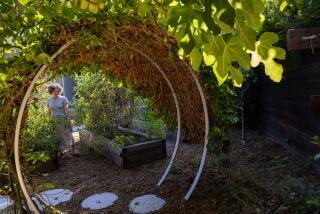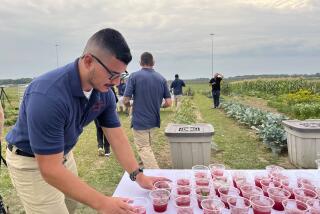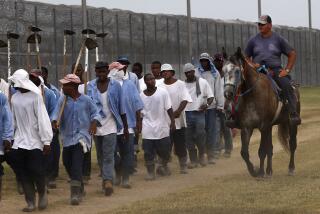The garden of restorative justice
- Share via
CHARLESTON, MO. — Bright-orange pumpkins are ripening in a 6-acre garden that provided a summer-long cornucopia of fresh vegetables for a food bank serving some of the poorest counties in Missouri.
Cultivating and harvesting the bounty were inmates at Southeast Correctional Center, where the garden is located.
For six hours a day, in one of the hottest summers in memory, they hand-planted, hoed, raked, weeded, watered and picked chemical-free produce, including tomatoes, cabbage, radishes and sweet corn, along with watermelon, cantaloupe, green beans, cucumbers, onions, zucchini and sweet potatoes.
Regional specialties of the garden in Missouri’s bootheel, just north of where some say the South begins, included okra, purple hull peas and turnip greens.
The offenders “gave their heart and soul to this,” said John Hilpert, the prison’s activity coordinator, noting that the produce was donated to a food bank in Sikeston.
“When you see the truck pull up, knowing this is going to a good cause. . . . One of us knows somebody who will benefit from this. They busted their tails for us.”
The Southeast Correctional Center project, started five years ago, is one of the state’s seven restorative justice gardens that prison officials say provide a way for offenders to repair some of the harm they caused with their crimes -- if not directly, in a symbolic way -- and to find healing within. Besides food banks, their produce is donated to schools, senior centers and other nonprofit groups.
Offenders participating in the gardens and other restorative justice activities also take classes in which they meet crime victims and reflect on the harm their criminal behavior caused.
The 40-hour curriculum is so popular that the class has a waiting list of 200 inmates.
Many offenders are “very remorseful for the crimes they committed and they want to give back to society in a positive way,” said Jeananne Markway, Missouri’s restorative justice coordinator. “They give their whole heart to these projects.”
Through the restorative justice project, Markway said, the offenders produce items specifically requested by someone in the community, such as blankets for nursing homes and children’s hospitals or posters, flashcards and other teaching aids for schools. Some make drawstring pants for hospitals to give to rape victims who have to surrender their clothes as evidence. Some of the inmates making the pants include those incarcerated for rape.
Restorative justice, a movement that started in the 1970s, usually involves victims meeting their offender to discuss how they’ve been hurt by the crime and what the restitution should be, said Howard Zehr, one of its pioneers, who runs the Center for Justice and Peacebuilding in Harrisonburg, Va.
There are 600 such programs in the nation today, he said.
Inmates who produced tens of thousands of pounds of vegetables at the garden in Charleston had varying levels of gardening experience.
George Williams and James Burton Jr. had farmed in their youth, while Ricky Hollywood and Hans Goeth barely knew a cucumber from a zucchini. Still, they quickly claimed certain plots as their own.
Williams, 54, the oldest of nine children who helped raise row crops on the family farm in southeast Missouri, taught younger, urban offenders how to vegetables. “A lot of guys had never seen a squash or an onion before,” he said. “When I came here in May, they were talking about starting up the garden [again], and I said, ‘Man, we’re behind.’ But we got it going. It was all adrenaline.”
Goeth, 29, who grew up surfing and skateboarding in Cocoa Beach, Fla., had no appreciation for those who labor to produce food. Now, they have his respect. While in prison, he had made toys for kids, but something about watering plants got him thinking deeply about God and the mystery of life. “I saw that I helped it and took pride in it,” he said.
Hollywood, 27, from Caruthersville, Mo., said he was glad for the opportunity to help others and proud that he knows enough to “go out and plant me a garden” after he is released.
Burton, 51, who grew up on a farm near Kewanee, Mo., knew what had to be done: “This is almost like being free here. I like knowing I’m giving to the elderly.”
At Oaks Senior Center in Sikeston, cook Dorothy Bonner said the produce donation from the food bank had cut her food costs by a third.
A regular patron, Lola Butler, 80, added, “For people like us, it’s a blessing.”
More to Read
Sign up for Essential California
The most important California stories and recommendations in your inbox every morning.
You may occasionally receive promotional content from the Los Angeles Times.










